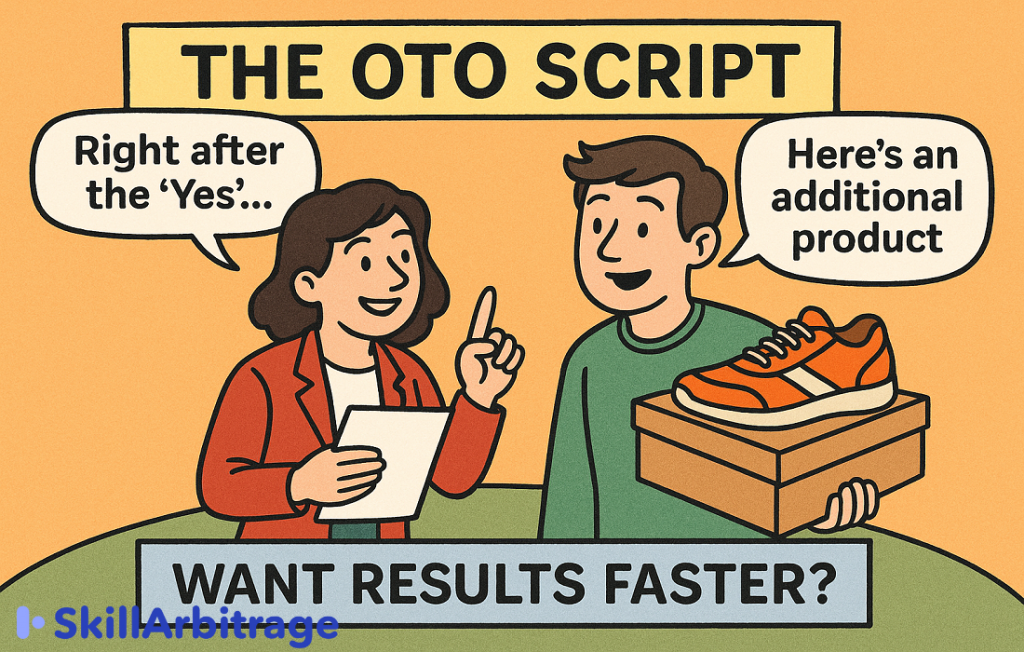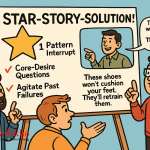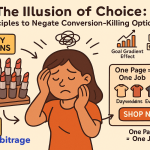This article is about upselling. You will learn how to use a short, proven script to offer a follow-up product right after a customer buys, without killing trust. By the end, you will know how to turn single sales into double sales, even if you’re new to freelancing.
Table of Contents
Previously on Star Story Solution…
Parvathishankar taught the trio how to pitch BareMode’s Rs. 8000 shoes to cold traffic using the Star Story Solution script, a way to turn strangers into first-time buyers fast.
In this article, Neel raises the stakes. Now they must upsell a second product in the same funnel. Parvathishankar returns to teach them the OTO script, the simplest way to get a second yes right after the first.
(Continued…)
Raja, Savitha, and Harsh walked into Parvathishankar’s flat like they had just cleared the UPSC.
They had done it.
Their Star Story Solution script had sold the Rs. 8000 BareMode shoes to strangers. Neel liked it. Swathi liked it. Even the first round of ad comments had the rare “link please?”
Harsh was already dreaming up the email flow. Savitha was polishing the landing page copy. Raja was muttering something about case studies.
Then Neel called.
“Looks good,” he said.
Pause.
“But how do we sell the coaching program on top of this?”
Harsh blinked.
“Wait. In the same funnel?”
“Yeah. They’re already buying the shoes. Upsell them the coaching right after. Make it sound like the next obvious step.”
Click.
They stared at each other.
Shoes were easy. Tangible. You can feel them. Photograph them. Hype them.
But now they had to convince people who had just spent Rs. 8000… to spend even more, on something abstract.
“What even is the coaching about?” Savitha asked.
“Founder’s notes,” Raja replied. “Behind-the-scenes product mindset, training modules, launch blueprints. Basically Neel’s brain in a box.”
Savitha frowned. “How do you pitch a brain in a box after someone’s already feeling good about just buying shoes?”
They all looked at Parvathishankar.
He sipped his filter coffee slowly, as if this exact problem visited him every week.
“This is a classic,” he said.
“Your job isn’t to convince them they want more. It’s to show them they’re not done yet.”
And just like that, he pulled a paper from under his notebook.
Three boxes. A headline. And a name at the top:
The OTO Script.
What is an OTO?
Harsh tapped the scribble on the whiteboard.
“Wait… what’s an OTO?”
“One-Time Offer,” said Parvathishankar. “It’s the upsell you show immediately after someone buys. Not in a follow-up email. Not a week later. Right after the first ‘yes.’”
Savitha raised an eyebrow. “Why then?”
“Because that’s the moment of momentum,” he said. “The card’s out. The trust is fresh. If there’s a time to offer more, it’s now.”
The big shift that improves conversions
Harsh rolled his chair back and stretched.
“I’ve seen those upsell pages that go on forever. Testimonials, charts, drama… felt more like a second sales page than a follow-up.”
“They used to work,” said Parvathishankar. “Back when people had patience.”
Savitha smirked. “And trust.”
Parvathishankar nodded.
“But things shifted. Long-winded upsells started killing the mood. Too much friction, too much overthinking.”
Raja looked up. “So what worked better?”
“Shorter scripts,” said Parvathishankar. “Not louder. Smarter. First, remind them what they just bought. Reaffirm that decision.”
“To reduce regret,” Savitha said.
“Exactly. Then,” he continued, “introduce something that logically completes what they just started. Not a new lane. Just the next step in the same direction.”
Harsh scribbled it down.
“Remind. Reinforce. Reveal.”
Parvathishankar smiled.
“Now you’re thinking like a closer.”
Structure first, script second
Raja spun the marker in his hand.
“So we just write a snappy pitch and hit record?”
Parvathishankar shook his head.
“Not yet. Script comes second. Structure comes first. You get that wrong, nothing else matters.”
Harsh raised an eyebrow. “Structure of what?”
“The offer itself,” he said. “The shape of the upsell. What it is. What it isn’t. 80% of your results come from that.”
Savitha leaned in. “So what are the rookie mistakes?”
“First,” said Parvathishankar, “selling more of the same thing. If they just bought a pair of barefoot shoes, don’t pitch them another pair. That itch is already scratched.”
Harsh laughed. “So no ‘Buy one more for your cousin’?”
“Not in the OTO,” Parvathishankar said. “Save that for emails.”
“And the second mistake?” asked Raja.
“Pitching something totally unrelated. You’re selling shoes, then suddenly you’re offering meditation music or a skincare routine. It breaks the chain of logic. You lose them.”
Savitha nodded.
“So the OTO has to feel like the next step on the same road.”
“Exactly,” said Parvathishankar. “Not dessert. Not detour. Just forward.”
3 proven OTO structures that convert
Here’s the next section continuing the story. It reveals the three proven OTO structures through dialogue, without naming them abstractly:
Parvathishankar drew three boxes on the whiteboard.
“Let’s talk about what does work.”
Raja leaned forward. “We’re listening.”
“First: give them the next thing. If someone bought these shoes to fix their posture, sell them a body reset routine or strength program. It takes them one step further down the same path.”
“Got it,” said Savitha. “It’s like, you’ve started the journey, now here’s what keeps you going.”
Parvathishankar nodded.
“Second: give them a faster way to win. People love speed. Offer a shortcut, a tool, or a trick to accelerate results.”
Harsh tapped his notebook.
“Like pre-recorded mobility routines?”
“Exactly,” said Parvathishankar. “Just be careful. Don’t make it sound like their first purchase was incomplete without it. That kills trust.”
“And the third?” asked Raja.
“Offer help. Some people want guidance. Give them access to a coach, a community, a done-with-you plan. That’s how you climb the value ladder.”
Savitha looked at the board, then back at him.
“So, either the next step, a faster step, or a helping hand.”
Parvathishankar smiled.
“That’s it. Pick the right one, and the script writes itself.”
OTO script outline
Harsh glanced at the draft page on his laptop.
“So we just drop the video right after checkout and say, ‘Surprise, here’s one more thing’?”
Parvathishankar shook his head.
“No surprises. No tricks. But also don’t close the door.”
Raja raised an eyebrow. “What do you mean?”
“Don’t say ‘Your order is complete.’ That ends the story. You want to keep the sales loop open.”
Savitha frowned. “So what do we say?”
1. Keep the sales loop open
Parvathishankar wrote on the board:
“Your order is not quite finished yet…”
He underlined it.
“That one line changes the frame. Instead of ‘we’re done,’ it signals, ‘there’s something important left.’ It keeps them in momentum. One step away from saying yes again.”
Harsh looked up.
“So it’s not pressure. It’s continuity.”
“Exactly,” said Parvathishankar. “The job’s not done. And you’re about to show them why.”
2. Congratulate and reinforce smart decision
The trio huddled around the whiteboard as Parvathishankar wrote the first line of the script:
“You made a smart choice. Here’s why…”
Savitha read it aloud. “Is this where we start flattering them?”
“No,” Parvathishankar said. “It’s where we kill regret before it starts.”
Raja nodded. “Reinforce the first yes.”
“Exactly. The second offer only works if the first decision feels good. This line isn’t praise. It’s confirmation.”
Harsh added, “So we remind them why they bought the shoes.”
“And connect it to what’s still missing,” said Parvathishankar. “That’s how we lead them forward without making them feel like they messed up.”
The copy wasn’t just about upselling.
It was about protecting the first yes.
3. 3x/2x question
Parvathishankar drew a box under the first line and wrote:
“How would you like to get the same result in half the time?”
Harsh raised an eyebrow. “That’s it? Just a question?”
“It’s not just a question,” Parvathishankar said. “It’s a fork in the road. If they’re even a little curious, they’ll keep watching.”
Raja leaned forward. “So we’re not selling yet. We’re just dangling a shortcut.”
Savitha smiled. “Like asking, ‘Want to run faster without training harder?’”
“Exactly,” said Parvathishankar. “You tease a better path. No pitch yet. Just the itch.”
It was a small line. But it changed the tone.
They weren’t pushing.
They were pulling.
4. Make it feel exclusive
Parvathishankar tapped the next line on the page.
“This is only available because you took action earlier.”
Savitha frowned. “Won’t that sound like fake urgency?”
“Not if it’s true,” he said. “This isn’t a discount on some leftover stock. It’s a reward for moving. They didn’t just buy a product. They earned access.”
Raja nodded. “So we’re not saying ‘limited time offer.’ We’re saying, ‘you unlocked a hidden door.’”
“Exactly,” said Parvathishankar. “You make them feel like insiders. Not just buyers.”
Harsh scribbled it down.
“You’re not being sold to. You’re being recognized.”
That line stuck.
5. Highlight the result and speed
Harsh tapped his pen against his notebook.
“So we’re just saying… ‘Buy this too’?”
Parvathishankar shook his head.
“No. You’re saying, ‘Want results faster? This is how.’”
Savitha looked up. “So it’s not about the product. It’s about speed?”
“And certainty,” Parvathishankar added. “You’re not selling more effort. You’re selling less time wasted. Fewer wrong turns. More control.”
Raja leaned back in his chair. “You’re not asking for another decision. You’re offering to protect the one they just made.”
Parvathishankar pointed at them both.
“Now you’re thinking like upsellers.”
6. Focus on one thing
Harsh was scribbling too fast now. His words started running into each other.
“We could show them the group calls, the modules, the bonus trainings, the community…”
Parvathishankar held up a hand.
“Stop. One thing.”
Harsh blinked. “Just one?”
“Always. The one thing that moves the needle. Everything else is noise.”
Savitha nodded slowly.
“So if the group calls are what actually help them stay on track, that’s the headline?”
“Exactly,” Parvathishankar said. “Don’t stack features. Spotlight the one that drives the result.”
Raja grinned. “So we’re not selling everything. We’re selling the thing that makes everything else work.”
Parvathishankar smiled.
“Now you’re getting it.”
7. Future pacing
Savitha tapped her pen against her notebook.
“How do we make them feel like they need it now?”
Parvathishankar leaned back.
“You don’t push. You pull them into the future.”
Harsh looked up. “You mean like, ‘Imagine where you’ll be six months from now’?”
“Exactly,” he said. “Show them the finish line. The energy. The change. Not in theory. In moments.”
Raja chimed in.
“So instead of saying, ‘Join the coaching,’ we say, ‘Picture yourself six weeks from now, lacing up your shoes, leaner, faster, already planning your first barefoot trek.’”
Parvathishankar pointed.
“That’s future pacing. You’re not just selling support. You’re selling what life feels like after the win.”
Savitha smiled.
“And once they see that version of themselves, they don’t want to let go.”
“Exactly,” he said.
“They’re not buying coaching. They’re buying that future.”
8. Call to action #1
Harsh was scribbling fast now.
“So how do we close it?”
Parvathishankar raised an eyebrow.
“You don’t close it. You continue it.”
Raja smirked. “Philosophical.”
“Practical,” Parvathishankar replied. “You’ve kept them in buying mode. Don’t break the flow with cleverness. Just tell them what to do next.”
Savitha nodded slowly.
“Like… ‘Click the button below to add this to your order.’”
“Exactly. Clear. Immediate. No thinking required,” he said.
Harsh underlined it twice.
“No fanfare. No fluff. Just the next click.”
“That’s how upsells convert,” Parvathishankar said.
“They feel like the next step, not a new decision.”
9. Guarantee
Savitha tapped her pen.
“But what if they hesitate? What if they’re unsure?”
“Then you remove the risk,” said Parvathishankar. “Make it a no-brainer to say yes.”
Harsh raised an eyebrow. “Like a refund?”
“More than that,” Parvathishankar said. “Make it bold. Make it feel unfair in their favor.”
Raja grinned. “Like, ‘Try it for 30 days and if you don’t feel ten years younger, we’ll give your money back and send you a sorry card.’”
Savitha laughed.
“But seriously. What do we say?”
Parvathishankar wrote it out slowly.
“‘If you don’t love it, we’ll refund you. No questions asked.’”
He looked up.
“You’re not just offering a product. You’re offering peace of mind.”
And just like that, the fear melted from the upsell.
10. Bonus stack
Harsh frowned at the page.
“We’re already selling a coaching program. What more can we throw in?”
Parvathishankar smiled.
“You don’t throw things in. You stack them. Intentionally.”
Raja looked up. “Like what? Worksheets? A checklist?”
“Not just anything,” said Parvathishankar. “Find the one thing people wanted from the main offer but didn’t get instantly.”
Savitha’s eyes lit up.
“The weekly gear breakdown we mentioned in the email. Everyone was asking about it.”
“Perfect,” said Parvathishankar. “Pull that out. Offer it here. Make it feel exclusive, but free. Like a thank-you for saying yes fast.”
Harsh nodded slowly.
“So we take the juiciest part… and make it feel like a surprise gift.”
“Exactly,” said Parvathishankar.
“That’s how you turn a ‘maybe’ into a ‘take my money.’”
11. Scarcity
Raja tapped the corner of the script.
“But what if they want to think about it and come back later?”
Parvathishankar didn’t even look up.
“They won’t.”
Savitha raised an eyebrow. “You mean they’ll forget?”
“I mean the moment is gone,” he said. “The psychology changes. They’ve already moved on. You need urgency.”
Harsh leaned back. “So we just tell them it’s now or never?”
Parvathishankar nodded.
“Politely. But clearly. You’re not being aggressive. You’re protecting the window where they’re most likely to say yes.”
Savitha scribbled in her notebook:
One-time offer. Only available on this page. Won’t be shown again.
She looked up.
“Scarcity without drama.”
“Exactly,” said Parvathishankar.
“It’s not a threat. It’s a fact.”
12. Call to action #2
Harsh clicked his pen twice.
“So we ask them to click again? Won’t that feel repetitive?”
Parvathishankar shook his head.
“First click was for the product. This one’s for acceleration.”
Raja frowned. “So what do we actually say?”
Parvathishankar pointed to the script box.
“You remind them of the benefit. And you link it to speed. That’s what makes it feel urgent without being desperate.”
Savitha tried it aloud.
“Click the button to get results faster.”
Harsh nodded.
“Short. Clean. Purposeful.”
Parvathishankar smiled.
“It’s not a second pitch. It’s the last nudge.”
And just like that, they had their closer. Not pressure. Just precision.
13. Testimonial rush
Savitha tapped the screen.
“This feels solid. But it’s still us saying it.”
Harsh leaned over. “You mean, no proof?”
She nodded. “We need voices outside this room.”
Parvathishankar agreed.
“Stack the page with testimonials. Short. Punchy. Focused on outcomes.”
Raja asked, “Like just one or two?”
“No,” Parvathishankar said flatly. “Flood it. You’re not making a case. You’re showing a crowd.”
Harsh scribbled a note. “So we pull every review, every result, every screenshot?”
“Yes,” said Parvathishankar. “You want the buyer to feel like they’re joining a winning team.”
Savitha grinned.
“Not convincing them. Surrounding them.”
“Exactly,” he said.
“Make them feel like the last person in the room who hasn’t said yes yet.”
The sun had dipped low, casting long shadows across the whiteboard.
Raja capped the marker. “That’s everything, right?”
Parvathishankar nodded, slowly. Then added,
“Almost.”
They looked up.
He tapped the script outline once, then looked at each of them.
“This isn’t a formula. It’s a scaffold. You build on it.”
Harsh raised an eyebrow. “So we don’t follow it word for word?”
“Use it like a jazz chart,” said Parvathishankar. “The rhythm is fixed. The melody is yours.”
Savitha smiled. “So we get to add our voice.”
“You have to,” he said. “That’s what sells. Not the template. You.”
They sat quietly for a moment, letting that land.
Then Raja laughed. “Guess we’re not selling shoes or coaching anymore.”
Harsh added, “We’re selling conviction.”
Savitha stood up. “And we’ve got the script. Time to go play.”
Parvathishankar gave a half-smile.
“Now you’re ready.”







 Allow notifications
Allow notifications
